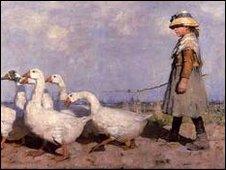People in Glasgow boys paintings revealed
- Published

Prue Whyte's great aunt Christina was the girl in the picture
More than 36,000 people have so far visited a new exhibition of work by the artists known as the Glasgow Boys.
Paintings by the group have been on show at Glasgow's Kelvingrove Art Gallery since April.
The exhibition has also helped shed some light on the people featured in the works.
One woman who has come forward said her grandfather and great aunt posed for the paintings.
The Glasgow Boys caused a sensation when they held their first major art show in 1885.
Their bold use of colour, natural subject matter and use of light earned them acclaim.
One of the paintings, A Highland Funeral, is based on a real event encountered by artist Sir James Guthrie.
He sketched the all-male gathering and later painted in the faces using inspiration from the people around him.
Prue Whyte is the grand-daughter of the young boy seen standing beside the coffin.
She revealed that her great grandfather had a studio in Helensburgh where the artist came to work.
She said: "Guthrie had no studio and my great grandfather had his own studio so Guthrie went and used his studio and used the children as models."
Where's Wullie?
Her great aunt, Christina, also features in one of the exhibition's most famous paintings, To Pastures New, showing a young girl herding geese.
She added: "I love the way in that painting Christina's feet sort of mirror the stepping of one of the geese."

Ms Whyte's grandfather was the young boy in A Highland Funeral
Jean Walsh, senior curator at Kelvingrove, said other families had come forward to tell their stories about posing for some of the paintings featured in the exhibition.
She said: "Most of them were just villagers' children and schoolmates.
"Guthrie got to know them because they were locals.
"After the sittings, his mother made them glasses of milk and cucumber sandwiches with white bread, which seemingly they had never had anything like that before."
The organisers of the exhibition are now keen to identify one recurring figure, known as Old Wullie, who features in several of Sir James Guthrie's Kirkcudbright paintings.